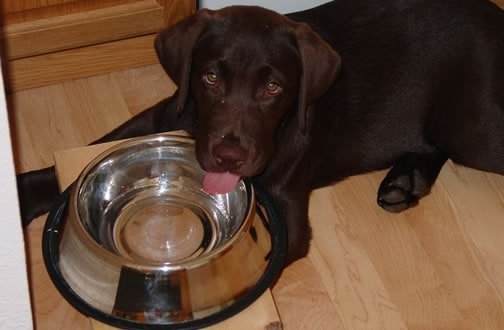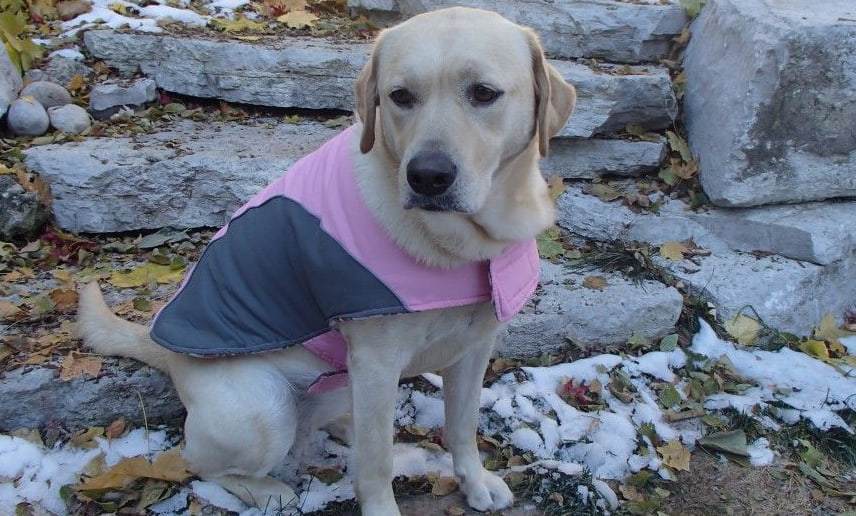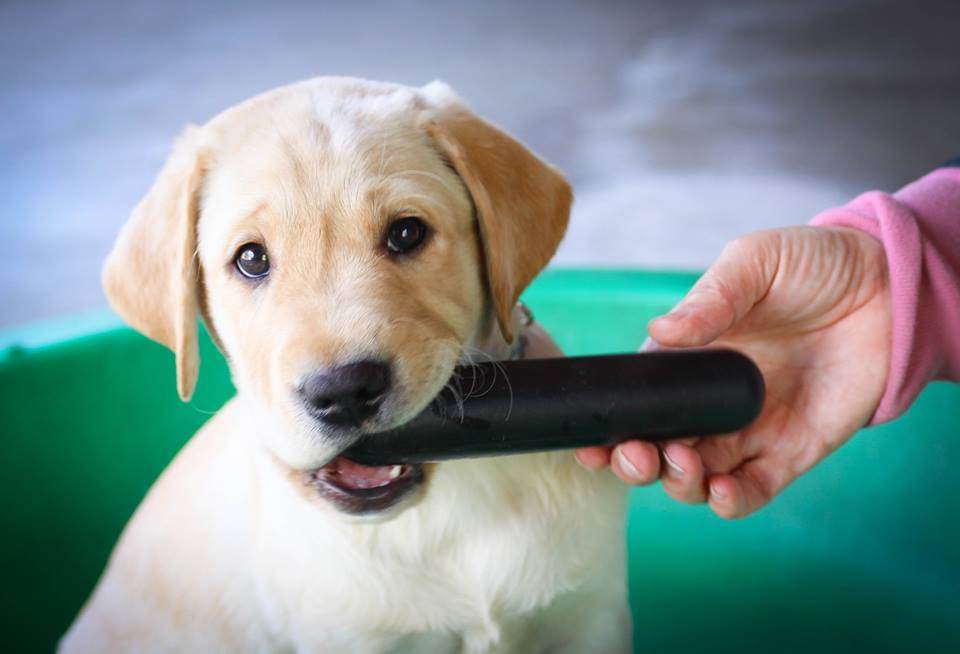Labradors need care in summer as well as winter season. When you get support from the family members then it becomes so easy to provide good care for the dog in any season. Nevertheless, there are some points which if taken care of can help anybody provide comfort to the Lab dogs.
Here are my top 9 tips for keeping a Labrador warm in the winter:
- A good quality resting place for your dog
- Convection Heaters Can Cause Accidents So Avoid Them
- De-hydration in Winter Should be Taken Care Of
- Snow in the Paws Can Cause Problems
- Keep Them Indoors on Windy and Snowfall Days
- Spread a Warm Blanket or Mat on the Floor for Him to Sleep
- Wipe Snow and Water when Dog Comes Indoors
- Change the Diet as Per Winter Season
- Frostbite is Dangerous for Labradors
I will be going into in-depth about the above points below. Make sure to take your notes of important details.
1) A good quality resting place for your dog (kennel or crate)
When the days get colder during winter, your Labrador doesn’t have to. Whether you’ve got an indoor dog that you would like to keep comfortable from cold drafts or an outdoor lab that needs your protection from the extreme temperatures, you should keep your pet warm with the right kind of crate or dog house.
If you have ever cuddled with your Lab, then you are conversant with the internal furnace that is always cranking. And if you have the right crate or dog house, then you can significantly benefit from that production of heat.
Selecting the right sized kennel for your Labrador will make a huge difference in the ability of the shelter to retain heat during winter. A small dog house will be too cramped for your pet, and an extra big one will have a lot of extra space to heat and insulate. The general rule of thumb is that the cold weather shelter should be big enough to allow your pet to move around comfortably.

When keeping your lab outside, you should know how to keep it warm, especially during the long winter nights. If possible, select a good insulated kennel or crate that’ll stand up to the weather elements and assist in keeping the cold drafts out.
If you’ve got a home-made kennel or crate, ensure to properly insulate the door, ceiling, and walls with something non-toxic such as EPS foam or hay.
Make sure you place your dog’s outdoor house out of the way of strong winds. Also, ensure that your dog’s shelter is raised a bit from the ground to avoid mud or pooling water. You can also put insulation on the floor to prevent your lab from losing heat that way.
Use kennel and crate covers when traveling
Traveling with your Labrador in your vehicle is a good thing because you can get some time to play with your pet during your breaks. However, the problem is that your truck can get pretty cold as you travel with your pet in the winter season.
In this case, you need a kennel cover to keep your lab warm in your vehicle. Insulated crate or kennel covers will not only keep your dog warm, but they also come with many holders and pockets for your convenience during your daily excursions.
An insulated crate cover will also keep your lab safe and warm when the temperatures begin to dip. That is especially important if your pet has been out for some time in the water. These covers will also keep your dog pretty comfortable on your ride home even when placed in the back of your truck.
Crate or kennel covers are not only essential for winter season rides in your truck, but they are also convenient when you want to put your pet in your garage when visitors come over, and especially if the visitors happen to be some family whose kids are terrified of dogs.
2) Convection Heaters Can Cause Accidents So Avoid Them
Temperatures that drop below the freezing point can be quite dangerous for outdoor pets that do not have an alternative heating source. While electric heaters or convection heaters can be utilized to heat your dog’s house, they pose serious safety risks, especially when operating in an enclosed area with flammable materials such as insulation.
Most dogs tend to seek heat whenever it gets cold outside, and your lab is likely to think that getting closer to a heat source is the best way to stay warm. That can be a big problem if you’re running some space heaters around your pets.
That being said, you should keep space heaters off your dog’s house, unless you are present to monitor what’s going on.
However, there are numerous ways to keep your dog warm during the winter season. Using a controllable heat pad is one of the most reliable and safest ways to provide your pets with constant and even heat in extreme temperatures.
3) De-hydration in Winter Should be Taken Care Of
Dogs can dehydrate as fast in the winter months as summer. During the winter season, the levels of humidity in the atmosphere are usually low. With the low humidity levels, your lab can easily get dehydrated if it is not drinking plenty of water.
There are various reasons why staying taking enough water is important for your Labrador’s bodily functions. One of these processes is the production of ATP or Adenosine Triphosphate. When your dog is dehydrated, the blood flow transmitting oxygen to the body cells is reduced, and ATP is produced at a pretty slower rate.

Although most dogs eat lots of snow in winter, it is not an adequate alternative for some freshwater. If your lab spends time outside in your backyard, make sure it has access to some water bowls. Always use plastic bowls outdoors.
Metal bowls normally freeze and can pose safety hazards to your lab’s tongue. Also, check the water bowl often and break any ice that builds on top.
Moreover, if your Labrador is wearing additional layers during the winter season, then it should drink some extra water. Whatever the case, hydration is still essential for your pet’s ability to regulate its body temperature.
4) Snow in the Paws Can Cause Problems (Avoid Outdoors on Colder Days)
Don’t overdo your Labrador’s playtime out in the snow. Just like small kids, dogs do not know when to quit. It might get carried away when making snow angels outdoors, so it is up to you to decide when it needs to come indoors and warm the pet up to prevent hypothermia and frostbite.
Extended exposure to extreme temperatures can significantly increase the risk that your Labrador will get frostbite or hypothermia. While their body coats protect most of the body parts, they have some areas that are pretty susceptible to frostbite.
Their ears, toes, tail, and nose can get affected by cold temperatures if you leave your pet outside for a long period.
5) Keep Them Indoors on Windy and Snowfall Days
One of the quickest ways to lose the insulation advantage your Labrador was born with is to let it get wet and then expose it to wind and snow. The wind has its way of cutting through, and moisture also opens the door even further. That emphasizes the need for an insulated crate or dog house.
You should, therefore, provide an incredibly warm environment for your Labrador. That seems like a no-brainer, but most pet owners do not realize how cold the winter climate can be when they’re wrapped up in warm coats, gloves, and hats.
If your dog lives outdoors, make sure you provide a dry, warm, secure, and comfortable space for your dog that offers a full wind-break.
When it comes to indoor pets, remember that they’re not used to being outdoors for prolonged periods, which can lead to frostbite and hypothermia sooner than dogs which are used to the winter weather.
6) Spread a Warm Blanket or Mat on the Floor for Him to Sleep
One of the major problems with young labs and other breeds of the retriever family is the fact that they like digging and chewing. The chewy nature of the Labradors can make acquiring them a good bed incredibly difficult because they don’t last for long.
Even the cheap dog beds get expensive, especially if you are always replacing them every three or two weeks. That’s one of the many reasons most Labrador owners prefer using crate mats or warm blankets on the floor.
The mats are not fluffy and soft, like other pet beds, which are the main qualities that force retriever breeds to chew. Although these mats and blankets do not provide the snuggle appeal that your lab might like, they are still better than sleeping on a hard floor.
The mat will easily insulate your pet to avoid losing body heat through the ground and keep it warm.
7) Wipe Snow and Water when Dog Comes Indoors
Just as human beings tend to develop some foot cracks in the winter season, puppies can also suffer from some cracked pads. If your lab has furry feet, you should trim the fur that grows between its pads to prevent the accumulation of ice between the pads.
The winter salts on city sidewalks might also burn your pet’s pads and are toxic. Therefore, after taking walks around the local neighborhood, you should wipe or rinse your lab’s paws to remove all salts and also prevent your dog from licking it off.
You should keep a designated towel handy for use when your lab comes in from playing outside in the snow. By doing this, you will speed up its drying time and keep it warm.
If your Labrador shows any signs of discomfort when it is walking outside on salted or frozen surfaces, you should consider using some booties to protect its paws.
8) Change the Diet as Per Winter Season
Nutrition is particularly important for your dogs in the winter season. Generally, the types of food nutrients your pet needs will significantly change depending on its breed and age, among many other things, but all dogs will need to eat some more food during the winter months.
Feeding time can sometimes be challenging when you’re trying to keep your Labrador warm during the winter season. The low body temperatures burn a lot of calories, which means that you should slightly increase the amount you feed your dog.
Increasing your Labrador’s calorie intake by approximately 30% will assist it in coping with the additional energy burned to retain body temperature.
On the other hand, Labradors tend to act as if they are hungry most of the time. Therefore, you should not rely on your dog to gauge the right amount it needs to remain healthy.
That’s because most people normally end up over-feeding their Labradors during the cold winter months. While you should increase the calorie intake, if you overdo it, you might end up doing even more harm than good.

9) Frostbite is Dangerous for Labradors
Frostbite refers to the damage caused to a dog’s skin and many other tissues as a result of extreme cold conditions. When the temperatures drop below 32°F, the blood vessels of your Labrador close to the skin begin to constrict or narrow.
The constriction of the dog’s blood vessels assists in preserving core body temperatures by diverting blood away from the cool parts of the body and towards the core.
In freezing weather or when the dog is exposed to cold temperatures for long-duration, this protective mechanism reduces the flow of blood in some parts of the body, particularly the extremities to incredibly low levels.
The reduced blood flow and cold temperatures can cause some tissues to freeze, leading to severe tissue injuries. Frostbite occurs mostly in body parts which are far from the heart and also in tissues with lots of exposed surface areas like the paws, tail, and ears.
Symptoms of Frostbite
The common symptoms and signs of frostbite include:
- It begins with a prickling feeling and cold skin
- Waxy-looking or hard skin
- White, red, greyish-yellow or bluish-white skin
- Swelling of the affected parts
- Skin ulcers or blisters
- Numbness
- Clumsiness due to muscle and joint stiffness
- Pain when the affected body parts are touched
Precautions for Frostbite
You can effectively prevent frostbite in your Labrador. Here are some tips to help keep your dog safe and warm during winter.
- Keep your Labrador indoors as much as possible. Take short walks and increase indoor activities like playing fetch and trick training to keep your pet mentally and physically active.
- Carry a towel with you on walks to wipe and clean off irritated and stinging paws.
- If your lab can tolerate it, place a hat or scarf around its ears to protect them from the cold temperatures.
- If your Labrador is long-haired, make sure you trim the hair around its feet to reduce clinging salt crystals, ice balls, and de-icing chemicals that can irritate the feet.
- Put booties on your dog’s feet to help prevent salts and sand from getting stuck between bare toes leading to irritation. If your lab does not like wearing booties, you can massage the paw pads with petroleum jelly or any other paw protectants before heading outside.
Conclusion
Compared to other dogs, Labradors need more care in the winter. Ignoring this can cause health issues with Lab dogs and results in pain and money later on. Every year, make it a point to follow the above guidelines and help your dog stay warm. Every dog is different so you will need to make adjustments as per your dog’s needs.
The above 9 tips are more than enough to help your canine stay warm. It’s not a big thing, just small adjustments make big differences.
References
- https://books.google.com/books?hl=en&lr=&id=ylvgMs4qct8C&oi=fnd&pg=PT19&dq=Keep+a+Labrador+Retriever+Warm+in+the+Winter&ots=iFnBtGgZ79&sig=l0vQt1o2BrpLiBPj4oxj0-DTWuU
- https://books.google.com/books?hl=en&lr=&id=u8R8CgAAQBAJ&oi=fnd&pg=PT7&dq=Keep+a+Labrador+Retriever+Warm+in+the+Winter&ots=pHX8VvBMAG&sig=xNNBCcd1H6j0FK3LsdKD1WyLymU
Table of Contents



